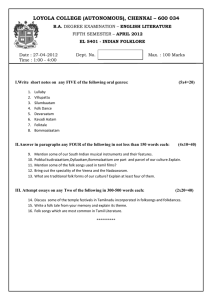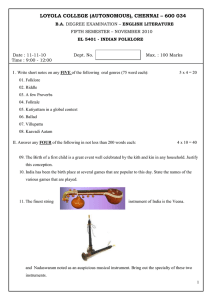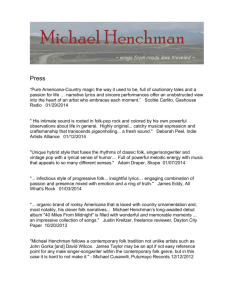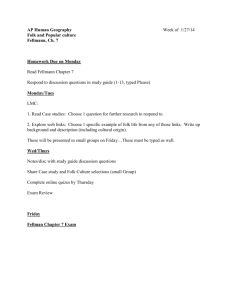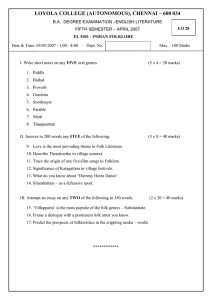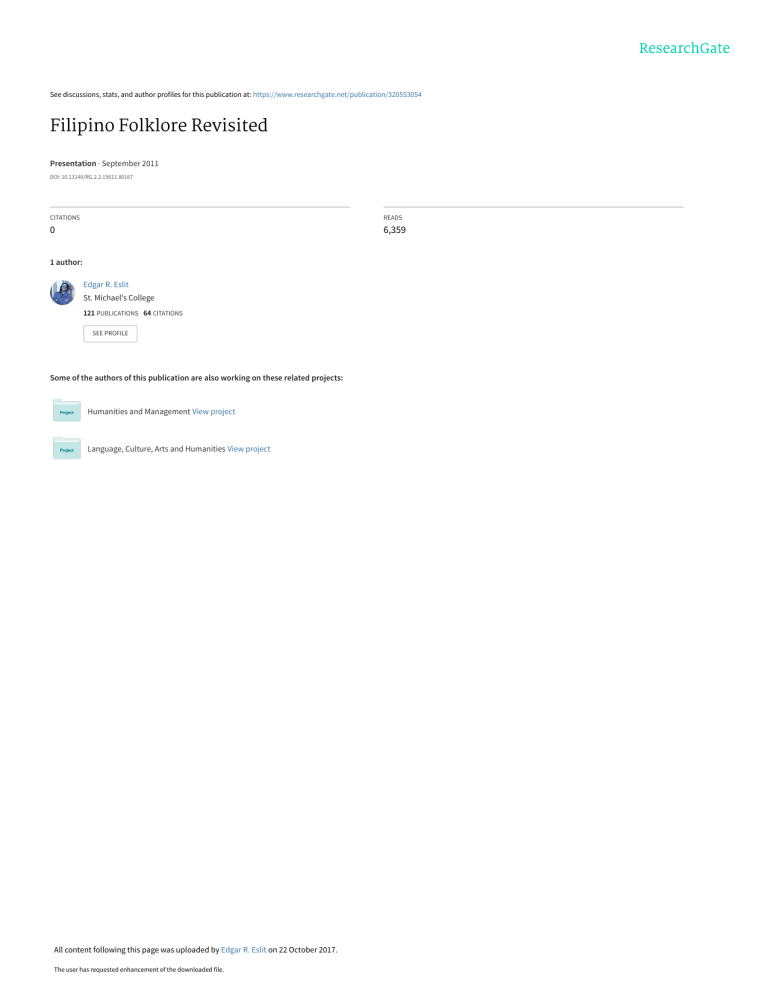
See discussions, stats, and author profiles for this publication at: https://www.researchgate.net/publication/320553054 Filipino Folklore Revisited Presentation · September 2011 DOI: 10.13140/RG.2.2.15611.80167 CITATIONS READS 0 6,359 1 author: Edgar R. Eslit St. Michael's College 121 PUBLICATIONS 64 CITATIONS SEE PROFILE Some of the authors of this publication are also working on these related projects: Humanities and Management View project Language, Culture, Arts and Humanities View project All content following this page was uploaded by Edgar R. Eslit on 22 October 2017. The user has requested enhancement of the downloaded file. Filipino Folklore Revisited Compiled by: Edgar R. Eslit A renowned Filipina folklorist, Dr. Damiana Eugenio, says there is still no universally accepted definition of the word "folklore". But any bit of knowledge handed down from generation to generation, which describes or depicts the beliefs and lifestyle of the ancestors of a chosen ethnic group, is rendered unique to that group, and is respected as folklore. Folklore is usually transmitted by word of mouth. Oral traditions are very common among the indigenous tribes still existent in the Philippines. What students of folk literature do, basically, is transcribe and interpret what is related to them by the storytellers of a tribe. The preservation of the knowledge of our elders can be carried out in many ways, and they are not inaccessible to anyone who would seek them. Recently, interest in folklore seems to have diminished. With the swift pace of modern living, looking back at our roots through spyglasses such as the study of folklore seems more and more difficult, if not pointless. The Filipino youth, especially, are more concerned with looking forward as the rest of the world hastens toward a technological future. We do not want to be left behind, after all. But if we were never meant to look back, why does the ancient saying "Ang siyang di lumingon sa pinanggalingan ay di makararating sa paroroonan (Whoever does not look back at a starting point, will not arrive at a destination)" remain in our lips? Why do we remind ourselves of the necessity of stopping to pay respect to our forebears and the advice they could still give? Philippine folk literature refers to the traditional oral literature of the Filipino people. Thus, the scope of the field covers the ancient folk literature of the Philippines' various ethnic groups, as well as various pieces of folklore that have evolved since the Philippines became a single ethno-political unit. While the difference between Philippine folk literature and Philippine mythology is a fine one, this article distinguishes folk literature as the source from which Philippine mythology derives. Philippine folk literature in oral and print formats While the oral, and thus changeable, aspect of folk literature is an important defining characteristic, much of this oral tradition has been written into a print format. To point out that folklore in a written form can still be considered folklore, Utely points out that folklore "may appear in print, but must not freeze into print."[1] It should be pointed out that all the examples of folk literature cited in this article are taken from print, rather than oral sources. Page 1 of 10 Categories of Philippine folk literature Eugenio classifies Philippine Folk Literature into three major groups: Folk narratives, folk speech, and folk songs. Folk narratives can either be in prose - the alamat (myth), the legend, and the kuwentong bayan (folktale) - or in verse, as in the case of the folk narrative. A legend (Latin, legenda, "things to be read") is a narrative of human actions that are perceived both by teller and listeners to take place within human history and to possess certain qualities that give the tale verisimilitude. Legend, for its active and passive participants includes no happenings that are outside the realm of "possibility", defined by a highly flexible set of parameters, which may include miracles that are perceived as actually having happened, within the specific tradition of indoctrination where the legend arises, and within which it may be transformed over time, in order to keep it fresh and vital, and realistic. A majority of legends operate within the realm of uncertainty, never being entirely believed by the participants, but also never being resolutely doubted. The Brothers Grimm defined legend as folktale historically grounded. A modern folklorist's professional definition of legend was proposed by Timothy R. Tangherlini in 1990:[3] Legend, typically, is a short (mono-) episodic, traditional, highly ecotypified[4] historicized narrative performed in a conversational mode, reflecting on a psychological level a symbolic representation of folk belief and collective experiences and serving as a reaffirmation of commonly held values of the group to whose tradition it belongs." Legend is a loanword from Old French that entered English usage circa 1340. The Old French noun legende derives from the Medieval Latin legenda. In its earliest Englishlanguage usage, the word indicated a narrative of an event. In 1613, English-speaking Protestants began to use the word when they wished to imply that an event (especially the story of any saint not acknowledged in John Foxe's Actes and Monuments) was fictitious. Thus, legend gained its modern connotations of "undocumented" and "spurious", which distinguish it from the meaning of chronicle. In 1866, Jacob Grimm described the fairy tale as "poetic, legend, historic." Early scholars such as Karl Wehrhan (de) Friedrich Ranke (de) and Will-Erich Peukert followed Grimm's example in focussing solely on the literary narrative, an approach that was Page 2 of 10 enriched particularly after the 1960s, by addressing questions of performance and the anthropological and psychological insights provided in considering legends' social context. Questions of categorising legends, in hopes of compiling a content-based series of categories on the line of the Aarne-Thompson folktale index, provoked a search for a broader new synthesis. In an early attempt at defining some basic questions operative in examining folk tales, Friedrich Ranke (de) in 1925 characterised the folk legend as "a popular narrative with an objectively untrue imaginary content" a dismissive position that was subsequently largely abandoned. Compared to the highly-structured folktale, legend is comparatively amorphous, Helmut de Boor noted in 1928. The narrative content of legend is in realistic mode, rather than the wry irony of folktale; Wilhelm Heiske remarked on the similarity of motifs in legend and folktale and concluded that, in spite of its realistic mode, legend is not more historical than folktale. In Einleitung in der Geschichtswissenschaft (1928), Ernst Bernheim asserted that a legend is simply a longstanding rumour. Gordon Allport credited the staying-power of some rumours to the persistent cultural state-of-mind that they embody and capsulise; thus "Urban legends" are a feature of rumour. When Willian Jansen suggested that legends that disappear quickly were "short-term legends" and the persistent ones be termed "long-term legends", the distinction between legend and rumour was effectively obliterated, Tangherlini concluded. The word legendary was originally a noun (introduced in the 1510s) meaning a collection or corpus of legends. This word changed to legendry, and legendary became the adjectival form of legend. Legends are used as a source of folklore, providing historical information regarding the culture and views of a specific legend's native civilization. "The Vanishing Hitchhiker" is the most popular and well known American legend. [23] The traditional tale type involves a young girl in a white dress picked up alongside of the road by a passerby. The unknown girl in white remains silent for the duration of her ride, thanks the driver, and quietly gets out at her destination. When the driver turns to look back, the girl has vanished. Often there a third character is included at the destination to add further suspicion to the girl's existence by informing the driver that they haven't seen anyone all night. "The Vanishing Hitchhiker" and stories like it, display the fears and anxieties that a Page 3 of 10 particular social group has. For example, the hitchhiking tale speaks to America's fascination with the road and also the anxieties that are inherent to travel. Folk speech includes the bugtong (riddle) and the salawikain (proverbs) Filipino proverbs Filipino proverbs or Philippine proverbs are traditional sayings or maxims used by Filipinos based on local culture, wisdom, and philosophies from Filipino life. The word proverb corresponds to the Tagalog words salawikain, kasabihan (saying) and sawikain (although the latter may also refer to mottos or idioms), and to the Ilocano word sarsarita. Proverbs originating from the Philippines are described as forceful and poetic expressions and basic forms of euphemisms. If used in everyday conversations, proverbs are utilized to emphasize a point or a thought of reasoning: the Filipino philosophy. One notable and locally popular example of a Filipino proverb is this: A person who does not remember where he (she) came from will never reach his (her) destination. Of Tagalog origin, it conveys and urges one person to give "importance in looking back at one’s roots and origins." The maxim also exemplifies a Filipino value known as the "utang na loob", one’s "debt of gratitude" to the persons who have contributed to an individual’s success. Damiana L. Eugenio, a professor from the University of the Philippines, author of Philippine Proverb Lore (1975), and who is also referred to as the "Mother of Philippine Folklore" grouped Filipino proverbs into six categories based on the topic expressed, namely: ethical proverbs (those that express a general attitude towards life and the laws that govern life itself), proverbs that recommend virtues and condemn vices, proverbs that express a system of values, proverbs that express general truths and observations about life and human nature, humorous proverbs, and miscellaneous proverbs. Usage: Philippine proverbs are further illustrated to be ornaments to language, words of ancestors handed down from one generation to another, and as wisdom gained from experience, which can be quoted to express a sentiment, a statement, or an opinion. Apart from this, Filipino proverbs are also used to prevent offending other individuals. This is one example of such a proverb: Bato-bato sa langit, 'pag tinamaan huwag magagalit, meaning "a stone thrown heavenward, if you get hit on its way down, don't get mad." Equipped with the appropriate and timely proverb, a Filipino can communicate empathy, and might be able to convince another person leading to the closure of an argument. Some Filipino proverbs are also intended to provide a warning, a lecture, an advice, and as a supporting statement for a particular viewpoint or issue. Folk songs can be sub-classified into those that tell a story (folk ballads), which are rare in Philippine folk literature, and those that do not, which form the bulk of the Philippines' rich heritage of folk songs. Page 4 of 10 Folk music includes both traditional music and the genre that evolved from it during the 20th century folk revival. The term originated in the 19th century but is often applied to music that is older than that. Some types of folk music are also called world music. Traditional folk music has been defined in several ways: as music transmitted by mouth, as music of the lower classes, and as music with unknown composers. It has been contrasted with commercial and classical styles. One meaning often given is that of old songs, with no known composers; another is music that has been transmitted and evolved by a process of oral transmission or performed by custom over a long period of time. Starting in the mid-20th century a new form of popular folk music evolved from traditional folk music. This process and period is called the (second) folk revival and reached a zenith in the 1960s. This form of music is sometimes called contemporary folk music or folk revival music to distinguish it from earlier folk forms.[1] Smaller similar revivals have occurred elsewhere in the world at other times, but the term folk music has typically not been applied to the new music created during those revivals. This type of folk music also includes fusion genres such as folk rock, folk metal, electric folk, and others. While contemporary folk music is a genre generally distinct from traditional folk music, in English it shares the same name, and it often shares the same performers and venues as traditional folk music. Even individual songs may be a blend of the two. Characteristics From a historical perspective, traditional folk music had these characteristics: It was transmitted through an oral tradition. Before the 20th century, ordinary farm workers and factory workers were usually illiterate. They acquired songs by memorizing them. Primarily, this was not mediated by books, recorded or transmitted media. Singers may extend their repertoire using broadsheets, song books or CDs, but these secondary enhancements are of the same character as the primary songs experienced in the flesh. The music was often related to national culture. It was culturally particular; from a particular region or culture. In the context of an immigrant group, folk music acquires an extra dimension for social cohesion. It is particularly conspicuous in immigrant societies, where Greek Australians, Somali Americans, Punjabi Canadians and others strive to emphasize their differences from the mainstream. They learn songs and dances that originate in the countries their grandparents came from. They commemorate historical and personal events. On certain days of the year, such as Easter, May Day and Christmas, particular songs celebrate the yearly cycle. Weddings, Page 5 of 10 birthdays and funerals may also be noted with songs, dances and special costumes. Religious festivals often have a folk music component. Choral music at these events brings children and non-professional singers to participate in a public arena, giving an emotional bonding that is unrelated to the aesthetic qualities of the music. The songs have been performed, by custom, over a long period of time, usually several generations. As a side-effect, the following characteristics are sometimes present: There is no copyright on the songs. Hundreds of folk songs from the 19th century have known authors but have continued in oral tradition to the point where they are considered traditional for purposes of music publishing. This has become much less frequent since the 1940s. Today, almost every folk song that is recorded is credited with an arranger. Fusion of cultures: In the same way that people can have a mixed background, with parents originating in different continents, so too music can be a blend of influences. A particular rhythmic pattern, or a characteristic instrument, is enough to give a traditional feel to music, even when it has been composed recently. It is easy to recognize the presence of a bagpipe or a tabla in a piece of music. The young are usually much less offended by the dilution or adaptation of songs this way. Equally an electric guitar can be added to an old song. The relevant factors may include instrumentation, tunings, voicings, phrasing, subject matter, and even production methods. Non-commercial. Origins: Throughout most of human prehistory and history, listening to recorded music was not possible. Music was made by common people during both their work and leisure. The work of economic production was often manual and communal. Manual labor often included singing by the workers, which served several practical purposes. It reduced the boredom of repetitive tasks, it kept the rhythm during synchronized pushes and pulls, and it set the pace of many activities such as planting, weeding, reaping, threshing, weaving, and milling. In leisure time, singing and playing musical instruments were common forms of entertainment and history-telling—even more common than today, when electrically enabled technologies and widespread literacy make other forms of entertainment and information-sharing competitive. Page 6 of 10 Opinions differed on the origins of folk music. Some said it was art music that was changed and probably debased by oral transmission—others said it reflects the character of the race that produced it. Traditionally, the cultural transmission of folk music is through learning by ear, although notation may also be used. The competition of individual and collective theories of composition set different demarcations and relations of folk music with the music of tribal societies on the one hand and of "art" and "court" music on the other. The traditional cultures that did not rely upon written music or had less social stratification could not be readily categorized. In the proliferation of popular music genres, some traditional folk music became also referred to "World music" or "Roots music". The American conception of "folk composition" has often drawn on Afro-American music. The English term "folklore", to describe traditional folk music and dance, entered the vocabulary of many continental European nations, each of which had its folk-song collectors and revivalists. The distinction between "authentic" folk and national and popular song in general has always been loose, particularly in America and Germany - for example popular songwriters such as Stephen Foster could be termed "folk" in America. The International Folk Music Council definition allows that the term can also apply to music that, "...has originated with an individual composer and has subsequently been absorbed into the unwritten, living tradition of a community. But the term does not cover a song, dance, or tune that has been taken over ready-made and remains unchanged." The post–World War II folk revival in America and in Britain started a new genre, contemporary folk music and brought an additional meaning to the term folk music. The popularity of "contemporary folk" recordings caused the appearance of the category "Folk" in the Grammy Awards of 1959: in 1970 the term was dropped in favor of "Best Ethnic or Traditional Recording (including Traditional Blues)", while 1987 brought a distinction between "Best Traditional Folk Recording" and "Best Contemporary Folk Recording". After that they had a "Traditional music" category that subsequently evolved into others. The term "folk", by the start of the 21st century, could cover singer song-writers, such as Donovan from Scotland and American Bob Dylan, who emerged in the 1960s and much more. This completed a process to where "folk music" no longer meant only traditional folk music. Folk song transformations and variations Music transmitted by word of mouth through a community, in time, develops many variants, because this kind of transmission cannot produce word-for-word and note-for-note accuracy. Page 7 of 10 Indeed, many traditional singers are quite creative and deliberately modify the material they learn. For example the words of "I'm a Man You Don't Meet Every Day" (Roud 975) are known from a broadside in the Bodleian Library.[16] The date is almost certainly before 1900, and it seems to be Irish. In 1958 the song was recorded in Canada (My Name is Pat and I'm Proud of That). Scottish traveler Jeannie Robertson from Aberdeen, made the next recorded version in 1961. She has changed it to make reference to "Jock Stewart", one of her relatives, and there are no Irish references. In 1976 Scottish artist Archie Fisher deliberately altered the song to remove the reference to a dog being shot. In 1985 The Pogues took it full circle by restoring all the Irish references. Because variants proliferate naturally, it is naive to believe that there is such a thing as the single "authentic" version of a ballad such as "Barbara Allen". Field researchers in traditional song (see below) have encountered countless versions of this ballad throughout the Englishspeaking world, and these versions often differ greatly from each other. None can reliably claim to be the original, and it is possible that the "original" version ceased to be sung centuries ago. Any version can lay an equal claim to authenticity, so long as it is truly from a traditional singing community and not the work of an outside editor. Cecil Sharp had an influential idea about the process of folk variation: he felt that the competing variants of a traditional song would undergo a process akin to biological natural selection: only those new variants that were the most appealing to ordinary singers would be picked up by others and transmitted onward in time. Thus, over time we would expect each traditional song to become aesthetically ever more appealing — it would be collectively composed to perfection, as it were, by the community. A literary interest in the popular ballad was not new; it dates back to Thomas Percy and William Wordsworth. English Elizabethan and Stuart composers had often evolved their music from folk themes, the classical suite was based upon stylised folk-dances and Joseph Haydn's use of folk melodies is noted. But the emergence of the term "folk" coincided with an "outburst of national feeling all over Europe" that was particularly strong at the edges of Europe, where national identity was most asserted. Nationalist composers emerged in Central Europe, Russia, Scandinavia, Spain and Britain: the music of Dvořák, Smetana, Grieg, Page 8 of 10 Rimsky-Korsakov, Brahms, Liszt, de Falla, Wagner, Sibelius, Vaughan Williams, Bartók and many others drew upon folk melodies. Regional forms The Steinegger brothers, traditional pipers of Grundlsee, Styria, 1880 While the loss of traditional folk music in the face of the rise of popular music is a worldwide phenomenon, it is not one occurring at a uniform rate throughout the world. While even many tribal cultures are losing traditional folk music and folk cultures, the process is most advanced "where industrialization and commercialisation of culture are most advanced".[17] Yet in nations or regions where traditional folk music is a badge of cultural or national identity, the loss of traditional music can be slowed; this is held to be true, for instance in the case of Bangladesh, Hungary, India, Ireland, Scotland, Latvia, Turkey, Portugal, Brittany, and Galicia, Greece and Crete all of which retain their traditional music to some degree, in some such areas the decline of traditional music and loss of traditions has been reversed. This is most obvious where tourist agencies brand some regions with the word "Celtic". Guide books and posters from Ireland, Scotland in Gaelic, English, Doric and Scots, Cornwall, Brittany and Nova Scotia refer to live music performances. Local government often sponsors and promotes performances during tourist seasons, and revives lost traditions. Four functions of folklore In a major article published in 1954, Bascom argued that folklore can serve four primary functions in a culture: Folklore lets people escape from repressions imposed upon them by society Folklore validates culture, justifying its rituals and institutions to those who perform and observe them. Folklore is a pedagogic device which reinforces morals and values and builds wit. Folklore is a means of applying social pressure and exercising social control. References: Page 9 of 10 1. Utely, Francis Lee. "A Definition of Folklore," American Folklore, Voice of America Forum Lectures, ed. Tristram Coffin, III 1968, p14. 2. Eugenio, Damiana (2007). Philippine Folk Literature: An Anthology, 2nd, Quezon City: University of the Philippines Press, 498. ISBN 978-971-542-536-0. 3. Osborne, Milton (2004). Southeast Asia: An Introductory History, Ninth Edition, Australia: Allen & Unwin. ISBN 1-74114-448-5. 4. Eugenio, Damiana (2002). Philippine Folk Literature: The Legends. Quezon City: University of the Philippines Press, 490. ISBN 971-542-357-4. Page 10 of 10 View publication stats

